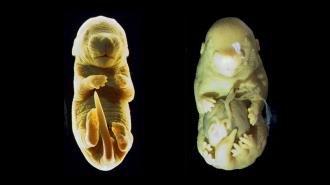In an attempt to study the spine, scientists in Portugal accidently created a mouse embryo with an extra pair of hind legs, where its genitals should be — and the strange turn of events could improve our understanding of human embryo development, metastatic cancer, and more.
What’s new? There’s a lot we still don’t understand about what goes on in the womb — how a single cell becomes an entirely new organism.
In an attempt to clear up some of this mystery, scientists at the Gulbenkian Science Institute in Portugal decided to study the gene Tgfbr1, which codes for a protein already known to play a role in embryo development.
“[We were] very surprised.”
Moisés Mallo
For their study, published in Nature Communications, the team inactivated the Tgfbr1 gene in mouse embryos that were halfway through development.
They expected that this might have some effect on the rodents’ spines. What they weren’t expecting was for one of their embryos to grow an extra pair of hind limbs where its external genitalia should have been.
“[We were] very surprised,” lead researcher Moisés Mallo told Newsweek.
But… how? Prior to this, scientists knew that, in most four-legged animals, external genitalia and hind limbs emerge from the same basic structures during embryo development.
“I would actually expect the same would happen in humans.”
Moisés Mallo
Upon further study, the Portuguese team discovered that the Tgfbr1 protein affects the cells that make up these structures, altering the way the DNA in them folds. By inactivating the Tgfbr1 gene, they affected the expression of other genes in the cells, leading to the structural abnormality.
“I would actually expect the same would happen in humans, but of course, this cannot be experimentally tested,” said Mallo.
Looking ahead: The researchers are hopeful that their study will improve our understanding of abnormalities that occur during human embryo development, given that mammals share many of the same early developmental pathways.
They plan to continue studying Tgfbr1 to see how it might affect the development of other body parts, including the immune system, as well as explore its potential impact on the structure of DNA in cancer cells and their ability to spread.
We’d love to hear from you! If you have a comment about this article or if you have a tip for a future Freethink story, please email us at tips@freethink.com.
